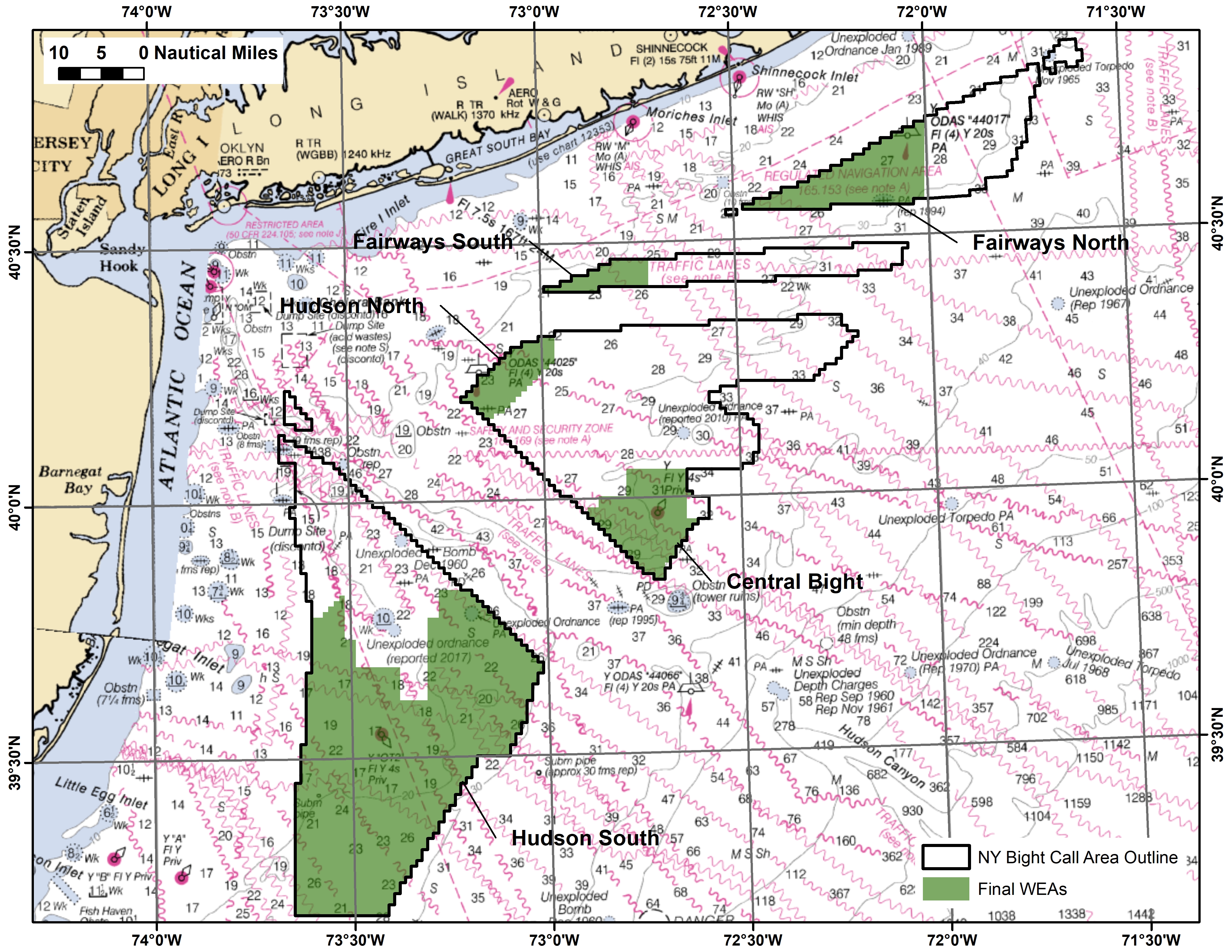Top Biden administration officials on Monday outlined new goals for building 30,000 megawatts off offshore wind energy generation by 2030, including another wind energy area covering nearly 800,000 acres in the New York Bight.
The Bureau of Offshore Energy Management announced it will initiate its environmental impact statement process for the Ocean Wind project, Ørsted’s planned 1,100 MW array off New Jersey, as the agency recently started an EIS for the South Fork wind development south of Rhode Island and just weeks after finalizing its analysis for the 804 MW Vineyard Wind project in southern New England waters.
Environmental reviews could start for as many as 10 more projects this year, the agency said.
The waters between the New Jersey beaches and Long Island already include federal lease held by developers intending to build the Atlantic Shores turbine array off Atlantic City, and the Empire Wind project close to the New York Harbor approaches. BOEM has been gauging potential developer interest in areas farther offshore and said it will now begin an environmental assessment of those areas.
With 20 million inhabitants in the region, it’s “the largest population center in the United States” with an enormous energy market, said Interior Secretary Deb Haaland, who spoke of the opportunity for U.S. shipbuilders and other industries in a new energy sector.
With Dominion Energy having the first U.S flag wind turbine installation vessel under construction, “it’s expected to be available to support U.S. offshore wind turbine installation in the next few years,” Haaland said.
New York State energy planners and wind power advocates have pressed BOEM to move ahead and preparing to lease more of the New York Bight, saying the offshore industry needs assurance that more areas will be available to spur investment. During an online conference Monday, administration officials stressed agencies across the federal government are not working in unison to speed wind development.
Energy Secretary Jennifer Granholm referred to the Trump administration’s years of mixed signaling on offshore wind, saying federal policy has been “like a chicken with its head cut off…but this is a new day.”
The Department of Energy will help provide “cash, coordination and creating union jobs” with research to advance the U.S. wind industry, including floating turbine technology, said Granholm, who called for support from “clean energy patriots.”
The cash part includes $3 billion in load support for the wind industry, while the Department of Transportation is looking for $230 million for port infrastructure improvements.
Commerce Secretary Gina Raimondo said the National Oceanic and Atmospheric Administration is entering a new data sharing agreement with wind developers Ørsted and new Sea Grant funding for studies on how wind development will impact ocean management.
“The agreement is the first of its kind between the offshore wind industry and the United States government, and it will provide the country with weather, water, and climate data, as well as forecasts and warnings so that we can best protect life and property and enhance the national economy,” said David Hardy, CEO of Ørsted Offshore North America. “Ørsted believes in making a concerted effort to work with all stakeholders so that we can grow key learnings and work together to provide data-driven solutions to protect our planet from global warming.”
Despite warm support from Mid-Atlantic state governments, the prospect of turbine arrays in some of the most heavily used waters off the East Coast is raising opposition, particularly from the commercial fishing industry and some in the recreational fishing sector, and beach communities worried about visual and tourism impact.
The Fisheries Survival Fund, representing East Coast scallop fishermen, still has an appeal pending in federal court to challenge wind leases under the Obama administration.
“Offshore wind energy development poses enormous risk to the marine environment and sustainable U.S. seafood production,” the Responsible Offshore Development Alliance, a coalition of fishing groups, said in response to the administration’s actions. “The Biden Administration’s disappointing fervor over its advancement continues an ineffective approach toward addressing climate change begun by previous administrations without demonstrating any willingness to include fisheries, ecosystem science, or our coastal communities in climate solutions.”
“The administration promised over $4 billion for offshore wind development, with a paltry $1 million to help Northeast coastal communities "improve understanding of offshore renewable energy" through NOAA’s Sea Grant program,” the group said. “Funding for science to truly understand the ecological and economic impacts of offshore wind is something all coastal communities desperately need, but a one-time, $1 million grant in only one region of the country is an ineffective attempt to pay lip service to the coastal communities that will experience significant impacts from the industrialization of their shorelines for decades to come.”
Advocates for wind development and longtime U.S. offshore service companies praised the Biden administration’s new commitments.
“The Biden administration brought the power of the federal government to kickstart a burgeoning industry into high-gear.,” said Liz Burdock, president and CEO of the Business Network for Offshore Wind, a nonprofit industry group. “Together with industry and union leaders, the administration is making the investments, supporting research, and advancing the permitting milestones needed to make offshore wind a foundation of America’s climate change response.”
“While the development of Atlantic wind opportunities will provide substantial benefits to the states adjacent to lease areas, it will also lead to tremendous investment throughout the nation,” said Erik Milito, president of the National Ocean Industries Association. “In areas like the Gulf Coast, you will find steel fabricators, heavy lift vessel operators, subsea construction companies, helicopter service providers and more who built their experience in the oil and gas industry but will be vital in building offshore wind.”







